Physical Address
304 North Cardinal St.
Dorchester Center, MA 02124
alanine aminotransferase
hepatitis B surface antigen
hepatitis B virus
hepatocellular carcinoma
hepatitis C virus
hepatitis delta virus
Hepatitis delta virus (HDV) is the sole member of the genus Deltavirus and is estimated to infect 15 million to 20 million people of all age groups worldwide. HDV is a human pathogen, and HDV infection can exist as an acute or chronic infection and occurs only in individuals who have active hepatitis B virus (HBV) infection. It is a defective RNA virus that requires hepatitis B surface antigen for assembly and transmission. It is currently the only chronically infecting human hepatitis virus that is without an FDA-approved therapy. Although rare, hepatitis D is known to be the most rapidly progressive viral hepatitis and the most likely to lead to cirrhosis, and as such may be viewed as the most severe form of human viral hepatitis.
The initial identification of HDV dates back to the mid-1970s during an investigation of a group of patients with HBV infection who developed severe hepatitis. During this investigation a novel nuclear antigen, coined the delta antigen , was discovered and initially thought to be a hepatitis B antigen. In subsequent chimpanzee experiments the delta antigen was identified as a structural component of a distinct pathogen that required HBV for its life cycle. The precise molecular origin of HDV remains a subject of speculation.
Since the discovery of HDV, HDV infection has been found in all age groups worldwide. Worldwide prevalence data, although improving through increased awareness, testing, and reporting, are still limited, and most reports are based on studies of seroprevalence of anti-HDV in hepatitis B surface antigen (HBsAg)-positive patients ( Fig. 34-1 ). Today it is believed that 15 million to 20 million people are infected with HDV; however, this estimation may have limited accuracy given the lack of systematic screening, the inability to identify HDV in immunocompromised patients, and the lack of HDV RNA testing to identify those who have maintained an antibody response despite loss of HDV RNA. Additionally, because of the severity of the disease and an accelerated progression to cirrhosis, more patients will likely die of HDV infection, resulting in a lower prevalence of the disease than might otherwise be expected.
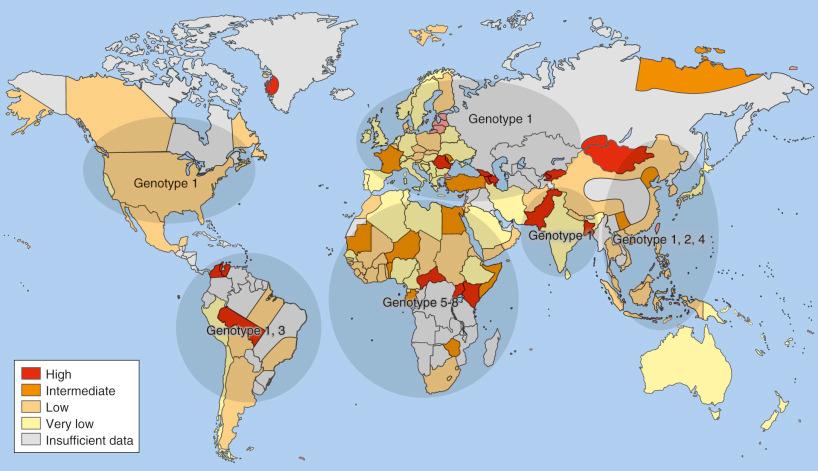
The approximately 36 nm diameter HDV particle contains a 1.7-kb single-stranded circular RNA genome of negative polarity. Currently, eight genotypes of HDV have been identified (see Fig. 34-1 ). These eight genotypes have up to 40% heterogeneity. Genotype 1 is known to exist worldwide and is the predominant virus in North America, Europe, and the Middle East. Genotype 2 has been identified predominantly in Asia, Southeast Asia, and Russia. Genotype 3 has been found predominantly in Central America and South America. Genotype 4 has been identified in Japan and Taiwan. Genotypes 5 to 8 have predominately been described to be found in Africa.
The genome forms a complex with the only known HDV-encoded protein, delta antigen, which exists in two isoforms, small and large. This RNA-protein complex is surrounded by a lipid envelope in which are embedded HBsAg proteins. The latter are the same three HBsAg isoforms (small, middle, and large [or pre-S1]) of HBsAg that are found on the HBV virion and that are myristoylated at its N-terminus, a modification that is important for host cell entry. HDV does not encode its own envelope proteins, but rather utilizes the envelope proteins of HBV ( Fig. 34-2 ). In this sense HDV is like a parasite of HBV. This source of envelope proteins for envelopment and subsequent viral entry is all that HDV requires from HBV, and provides a molecular explanation for why HDV infections naturally occur only in the context of a coexisting HBV infection. As detailed further in subsequent sections, the net effect is to make the clinical disease generally more severe than would otherwise be associated with HBV monoinfection.
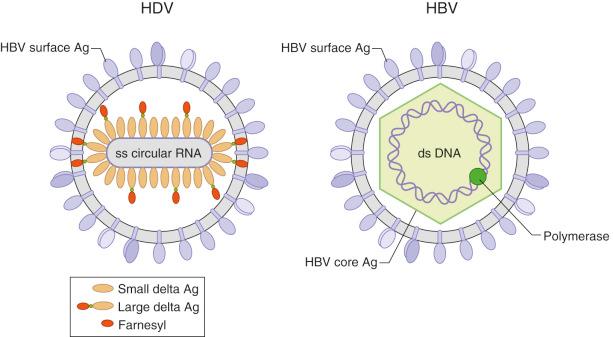
Sodium-taurocholate cotransporting polypeptide, which plays an important role in bile acid uptake into the liver, was recently identified as a critical receptor for both HBV and HDV entry. On uncoating, the viral genome is transported to the liver host cell nucleus, where genome replication occurs ( Fig. 34-3 ). The latter consists entirely of RNA to RNA replication, with no DNA intermediates or chromosomal integration events. The mechanism of RNA-dependent RNA replication proceeds via a so-called double rolling circle model, wherein the incoming negative-strand genome serves as a template for a presumably host cell–encoded RNA polymerase activity that produces linear multimers of opposite polarity, or antigenomic, RNA. The latter are processed into linear antigenomic monomers via specific cleavage at a ribozyme site encoded in the antigenomic RNA. The monomers are ligated into antigenomic circles that serve as a template for production of linear multimers of genomic RNA, which are processed via a separate ribozyme activity into linear genomic monomers. These again undergo a ligation event to yield progeny genomes for packaging. In addition, a small antigenomic transcript serves as messenger RNA for production of delta antigen. During HDV genome replication, RNA editing events occur, catalyzed by adenosine deaminases acting on RNA 1 (ADAR1). One of these editing events results in the mutation of the stop codon for delta antigen. As a consequence, translation of delta antigen proceeds to the next downstream stop codon, leading to the addition of an extra 19 amino acids to the C-terminus of the small (195 amino acid, ~24 kDa) delta antigen, which results in the production of the large (214 amino acid, ~27 kDa) delta antigen. Although the small and large delta antigens share most of their sequence and can oligomerize for copackaging, the two delta antigen isoforms have very different functional activities. The small delta antigen promotes genome replication, whereas the large delta antigen is a potent transdominant inhibitor of genome replication. In addition, only the large isoform is capable of interacting with HBsAg and initiating particle formation and assembly. Thus the RNA editing event can be viewed as a key regulatory switch in the virus life cycle, signaling an end to genome replication and initiation of packaging and virion morphogenesis ( Fig. 34-4 ).
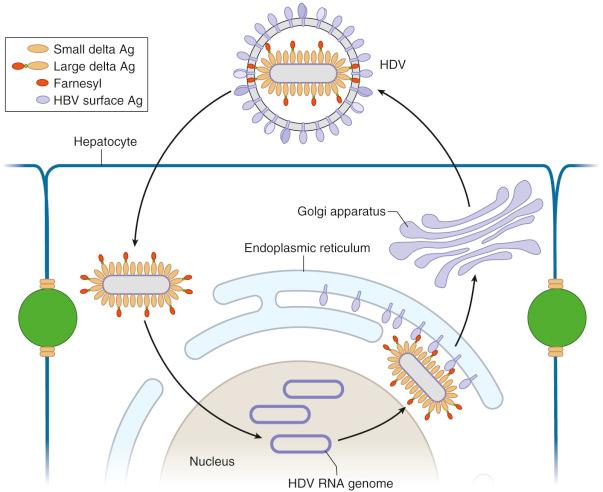
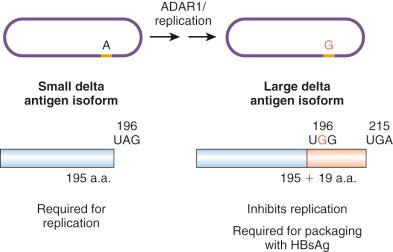
The mechanism of particle assembly is dependent on a site-specific lipid modification at the extreme end of the large delta antigen. This involves the covalent addition of the prenyl lipid farnesyl to cysteine contained within a so-called CXXX box amino acid sequence (where C is cysteine and X is one of the last three amino acids at the extreme C-terminus of large delta antigen). This reaction is catalyzed by the host enzyme farnesyltransferase.
As described in further detail later, to date the roles of myristoylation and prenylation in the HDV life cycle have yielded the most advanced therapies for hepatitis D in development. A variety of other posttranslational modifications have been described on delta antigen, including phosphorylation, sumoylation, methylation, and acetylation. These, along with the RNA-dependent RNA replication, RNA editing, ribozyme cleavage, and RNA ligation activities, are potential future targets for antiviral intervention.
The natural reservoir of HDV is humans, but experimental transmission occurs in chimpanzees and woodchucks that are infected with HBV or woodchuck hepatitis virus respectively. In the case of the latter, the HDV genome and delta antigens become pseudotyped with woodchuck hepatitis virus surface antigen proteins. The drawbacks of these models include a lack of the defined genetic background afforded by a highly inbred and increasingly annotated species such as the mouse.
Mice transgenic for the delta antigens have also been used to explore the pathogenesis associated with these proteins, and transgenic mice expressing a replication-competent HDV genome allowed tissue tropism to be studied with respect to genome replication. Hydrodynamic transfection of mice transgenic for HBV with HDV genomes has been used to evaluate the in vivo efficacy of prenylation inhibitors. Mice with humanized livers have been used to study the infection initiated with natural inoculums of HDV and to evaluate the effect of candidate entry inhibitors. In such a system, genetically engineered immunodeficient mice are subjected to a hepatotoxic insult, followed by transplant of primary human hepatocytes. Although relatively high levels of viremia can be established in this type of humanized mouse, the lack of an effective adaptive immune system limits the types of questions that can be answered. Finally, mice transgenic for the liver sodium-taurocholate cotransporting polypeptide have recently been shown to support infection with HDV, although in the absence of HBV coinfection, HDV could not spread and appears to be resolved by the innate immune system.
Despite the estimation that 15 million to 20 million people are infected worldwide, certain regions of the world have been identified as endemic for HDV infection. These areas of high prevalence include Central Africa (15% to 50%), West Africa (17% to 30%), the Mediterranean basin (27%), the Middle East (Iran, 7.8%), northern Asia (Mongolia >26% and >6% in school-aged children, although a more recent survey reported a prevalence of 60%), the Amazonian basin of South America (13.5% to 29%), eastern Europe, including Romania (20.4%), parts of Russia (21.8%), and parts of Southeast Asia, including Vietnam (15.4%).
After the discovery of HDV in Italy, HDV was reported to be endemic in southern Europe between 1980 and 1990 with prevalence rates greater than 20%. Since that time the prevalence rates have significantly declined as a result of the use of disposable needles and syringes, improvements in socioeconomic factors, and the implementation of HBV vaccination programs, as well as deaths among those chronically infected. However, with migration from high endemic areas, HDV prevalence rates in Europe have risen in recent years, with increased prevalence rates reported in Germany, France, and England.
In Asia, also in the mid-1980s, HDV infection was reported to be as high as 24% in Taiwan, but saw a decline to 4% in the next 10 years. This decline is believed to be as a result of transitioning to the use of disposable needles and syringes and educational campaigns for the use of prophylaxis with unsafe sex practices. Similar rates were reported for the Irabu Islands of Okinawa, Japan, in the 1990s, with increasing rates in older patients compared with younger patients, suggesting a decline in transmission over time.
In the United States there is a paucity of data on HDV prevalence. One study describing the prevalence of HDV in HBV-infected patients in northern California identified a rate of 8% (only 42% of HBsAg-positive adults were tested). In a Veterans Health Administration population where testing for HDV was suboptimal (8.5% of HBsAg-positive adults), HDV antibody positivity was identified in 3.4% of HBV-infected individuals. Among injection drug users in Baltimore, Maryland, approximately 50% of HBV-infected individuals were found to be infected with HDV. This suggests potential subgroups of HBV-infected patients are at high risk of unrecognized HDV infection within developed countries. Immigration from endemic areas remains a significant risk factor for HDV infection within the developed world.
In humans the routes of HDV transmission are identical to those of HBV, and the epidemiologic patterns are thought to be similar. Parental transmission is the most commonly reported mode of transmission, and injection drug use remains the most significant risk factor for transmission in developed countries. Sexual transmission occurs in both heterosexual populations and in men who have sex with men. Vertical and neonatal transmission is now rare and tends to occur in medically underserved areas where vaccination programs designed to interrupt vertical transmission of HBV are inadequate.
Transmission of HDV in humans occurs by one of two routes: either via coinfection with acute HBV infection or as superinfection in patients with preexisting chronic HBV infection ( Figs. 34-5 and 34-6 ). In chimpanzee models the length of the incubation period depends on the HDV titer of the inoculum, with doses of 1 mL of inoculum diluted from 10 0 to 10 −11 dilutions yielding the detection of hepatitis delta antigen in the liver from 14 days to 35 days after inoculation. In chimpanzee experiments, only 10 HDV genomes per infectious dose are required for transmission. In coinfection, a simultaneous infection occurs in a previously unexposed individual with both HBV and HDV, leading to an acute hepatitis B and D. Clinically, coinfection may cause a severe acute hepatitis along with the potential for acute liver failure (in 2% to 20%).
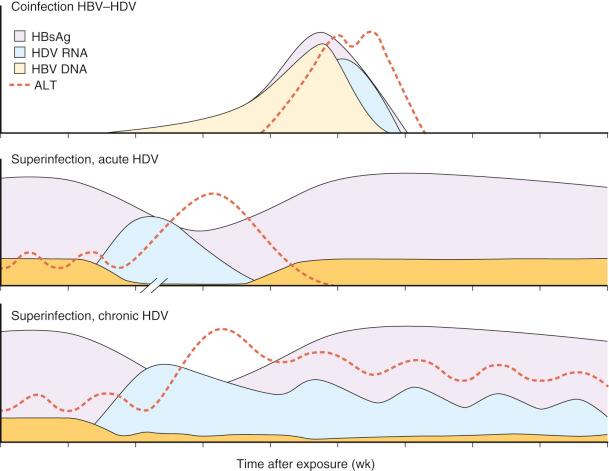
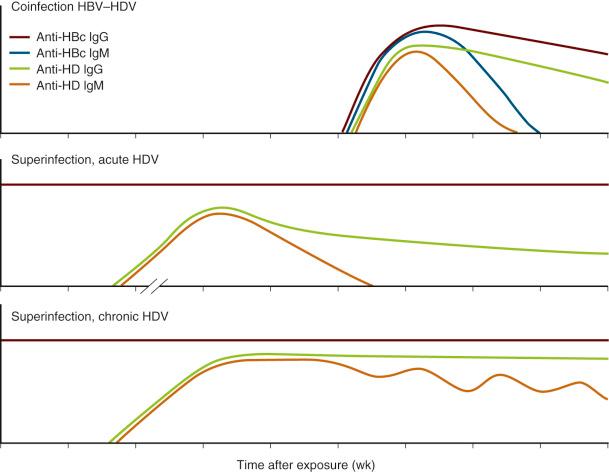
Chronicity is less frequent during coinfection, occurring in less than 5% of adults.
HDV superinfection, which is more common than coinfection, occurs when HDV is transmitted to an individual who already carries HBsAg (indicative of a previously established hepatitis B infection) (see Figs. 34-5 and 34-6 ). Clinically, superinfection with HDV may be mistaken for a flare of chronic hepatitis B with significant elevation of serum aminotransferase levels. Superinfection has been associated with acute liver failure and severe chronic active hepatitis that often progresses to cirrhosis. Chronicity occurs in up to 95% of cases.
There has been some controversy about whether HDV can exist as a monoinfection without virulence. Evidence of HDV was found in transplanted livers with the detection of hepatitis delta antigen shortly after liver transplantation. However, it is believed that this apparent isolated HDV viremia was more likely due to the limited sensitivity of certain HBV diagnostic assays. In contrast, HDV monoinfection has been described to persist intrahepatically for 6 weeks before being rescued by HBV in humanized mice models. Additionally, in woodchucks, HDV has lasted 1 month in the absence of HBV, and in chimpanzees it has lasted for 1 week.
Become a Clinical Tree membership for Full access and enjoy Unlimited articles
If you are a member. Log in here